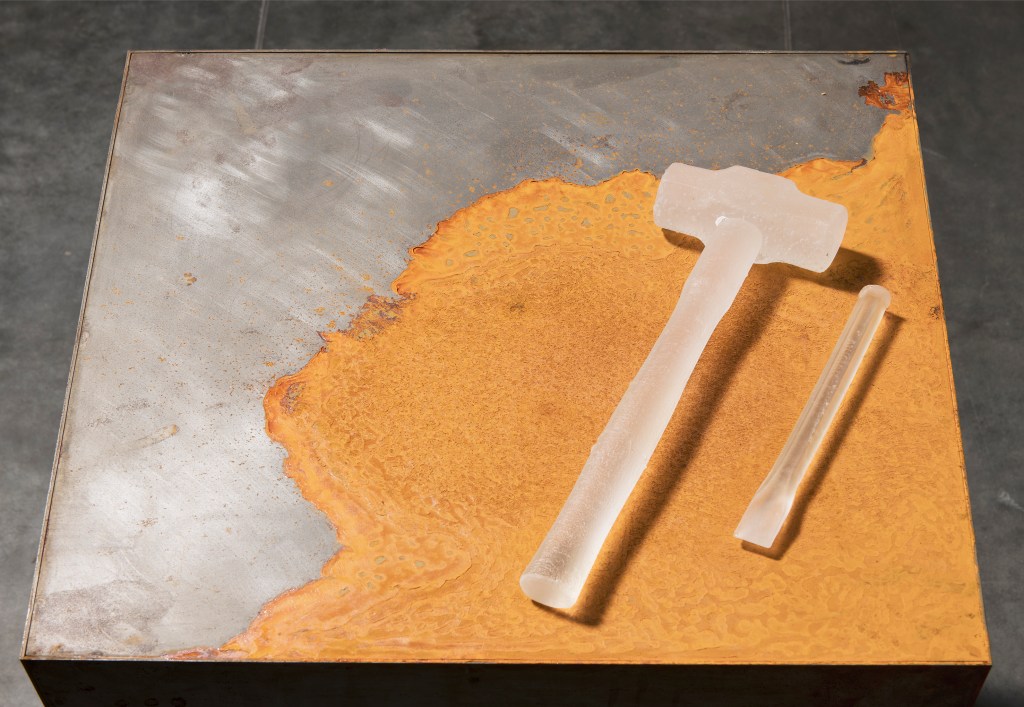Opening the 2024 exhibition program, Nicholas Burridge: Built Geologies, curated by Aimee Frodsham, is a survey of the experimental body of work produced by Burridge during his 2023 residency at Canberra Glassworks.
The exhibition is a successful synthesis and continuation of his interventions in basalt, a sedimentary rock local to the Victorian Volcanic Plains of Naarm/Melbourne, where he is based. By activating this material back into its prehistoric, fluid glass-rock state, Burridge positions himself as the resource-extracting brute force that is the “hand” of the Anthropocene. Yet, where the prescriptive narrative of an Earth at the verge of ecological collapse should follow, Built Geologies widens our viewfinder far beyond our epoch, invoking moments of tension that feel strangely soothing.
As aptly described by the opening speaker, Canberra-based artist and lecturer Dr Jacqueline Bradley, Burridge is concerned with our conceptual grasp of deep time: a scale of geological events so vast that it is arguably incomprehensible to the human brain. To circumvent this, the exhibiting works present imaginary temporalities, or ‘opportunities to time-travel’, to borrow Bradley’s words.
In the re-cast basalt series (2024), ancient basalt formations melt into pooling liquid forms through the grid of rebar frames and onto the gallery floor. It is as though we are peering through a slice of the spacetime continuum, where man-made architectural structures meld with viscous, smouldering lava. Similarly, in (pouring) volcanic form-work (2024), geometrically-cut tiles of basalt are fitted to contain the same rock in raw, molten form, which droops languidly in a neat recess cut into the stone.

In the foyer, the stone artefact series (2024) presents a hammer, chisel and crowbar cast in translucent glass. As the title suggests, these tools date back to prehistoric times when they were carved from stone; yet here the moulds are taken from industrially fabricated counterparts bought from Bunnings. As lustrous and fragile glass casts, the tools are transformed into aesthetic items. Paradoxically, they also become unimaginably more durable than if they were to be made from steel which, while strong, is highly susceptible to being corroded.
But what is to be done with a glass hammer that would break into pieces on the first use? Burridge’s thought experiments on the strength of glass culminate in load bearing (2024), installed in the dome-shaped Smokestack Gallery. For this work, Burridge tested the bearing capacity of various sheets of glass, reverse-engineering the point when it would just hold together when bearing the weight of an auger.
Burridge’s confidence and ability to present works that bear the mark of a highly experimental ethos is commendable. Yet, in a building as historically charged as the Kingston Power House, opportunities to invoke temporal boundaries abound. As the first permanent public building and first site of coal-powered electricity generation in the federal capital, the building is filled with haunting material provocations. There are coal hoppers, for example, which bear vestigial scratches from when workers would need to hit them to dislodge large coal stones.
Read: Exhibition review: Salote Tawale, Carriageworks
What’s more, Canberra Glassworks is already highly successful in blurring the otherwise neat divides of front and back of house. For this very reason, it would have been interesting to conceive ways through which Built Geologies could have resonated more directly with the various spatial structures and meanings inherent within the building. While not a concrete outcome, it was certainly imaginable, which is invariably a win for Burridge.
Nicholas Burridge: Built Geologies is on view at Canberra Glassworks from 20 January to 25 February; free.
This review is published under the Amplify Collective, an initiative supported by The Walkley Foundation and made possible through funding from the Meta Australian News Fund.





